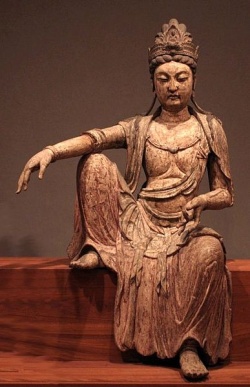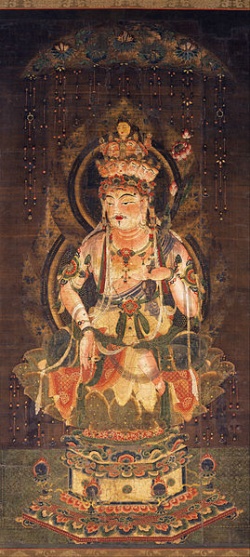Introduction of Bodhisattva Guanyin
She is commonly known as the Goddess of Mercy.
In Chinese Buddhism, Guanyin (or Guanshiyin) is often portrayed as a woman.
The name of Guanyin (also spelled as Kuan Yin, Kwan Yin, or Quan Yim) has a profound meaning of "The One who hears the cries of the World".
She is the most beloved and revered of the Chinese deities.
The Characteristics of Guanyin are all we long for: merciful, tender, compassionate, loving, protecting, caring, healing, kind, pure, and wise.
She quietly comes for care of her children everywhere.
Many scriptures state that one can invoke Guanyin's assistance by simply calling out her name.
Many feel that this female bodhisattva is very approachable, which reinforces her motherly image.
Just as Catholic and Christianity have provided an antidote to pure theological figure of the reverence of the Virgin Mary, so Chinese religion evolved a feminine bodhisattva, name Guanyin.
Just as Mary captured the hearts of Catholic prayers, Guanyin has gain more popularity than the male bodhisattvas in both Japan and China.
She is one of the most spiritual being in the entire Chinese culture.
Guanyin is depicted in various forms and poses. She often appears in white, the color of purity, and her gowns are long and flowing. Often she holds a vast which symbolized her pouring compassion on to the world.
Often, she might be holding a willow branch, which is a symbol of being able to bend or being flexible.
Other time, she will be seen holding a child, a reminder of her role as a motherly loving figure. Another common appearance of Guanyin is one having a thousand arms and thousand eyes.
Her arms allow her to reach out to the suffering individuals, while thousand eyes help her see anyone who needs for attention.
Sometime, you might see Guanyin standing with a peacock, since the spread tail feathers of a peacock look like they have eyes in them.
She might be seated or standing on a lotus flower, which means purity that grows out from mud.
The profound meaning is that our lives might be surrounded by unpleasant issues, but we ought to keep our heart pure like the lotus flowers.
By 1200 AD, Guanyin was represented to be a beautiful Goddess with flowing robes.
In several illustrations, Guanyin is described as a Goddess with many arms and hands. The hand is illustrated to have an eye in each palm.
This implies that that the Goddess of Mercy is watching over everyone. She is also known to be the right eye of Buddha.
Guanyin as Giver of Child(ren)
Guanyin is also titled as "Giver of Children, since the concepts of fertility are associated with the female gender.
She is often approached by couples with fertility issues so that she can gift them with a child.
It is said that Guanyin cares for the souls of people from their birth to their death.
Legends suggest that Guanyin is the one who sends the newborn children into their parents’ hands.
The influence of the Guanyin's maternal role has reached many countries all over Asia.
Guanyin has many names
Guanyin is also given different names such as the “The Gentle Protector”, “The Bodhisattva of Compassion” and “The Bodhisattva of Compassion”. No matter what she is called, Guanyin was always believed to represent absolute love and compassion.
Guanyin is a single spirit that possesses a very complex energy presence.
There are numerous other forms/manifestations of Guanyin throughout Asia; in Japan alone there are 33 different manifestations.
You will find temple/shrines dedicated to her in China, Burma, Cambodia, Indonesia, Korea, Japan, Laos, Malaysia, Singapore, Thailand and Vietnam.
The name Guanyin represents the Chinese name of the goddess that is as compassionate as a mother.
This characteristic is thought to have resulted Guanyin to obtain a deep involvement with the people who are in need.
The names and forms/manifestations of Guanyin are not significant.
Being from the realm of emptiness where there are neither categories nor relevance. Rather the purposes is to take whichever form/name is necessary to help the individual being.
Regardless of where the Guanyin’s names/manifestations originated, people who admire her all share the same belief that Guanyin symbolizes kindness, pure energy, enlightenment and rebirth.


